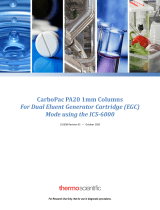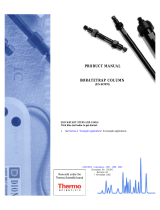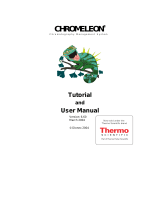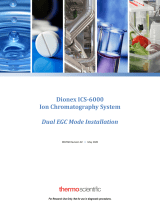Page is loading ...

Polishing Amperometry Cell
Gold Working Electrodes
for

Product Manual for Polishing Amperometry Cell Gold Working Electrodes Page 1 of 2
Product Manual
for
Polishing Amperometry Cell
Gold Working Electrodes
© 2009 Dionex Corporation
Document No. 031154
Revision 02
March 2009
Document No. 031154-02 © 2009 Dionex Corporation March 2009

Product Manual for Polishing Amperometry Cell Gold Working Electrodes Page 2 of 2
Document No. 031154-02 © 2009 Dionex Corporation March 2009
1. POLISHING GOLD WORKING ELECTRODES
A layer of contamination may occasionally build up on the gold working electrode of the amperometry cell. When this
occurs, the electrode must be polished to restore performance.
The manuals for the ED, ED40, ED50 and ICS-3000 ED present a method in which the working electrode is first polished
with a coarse polishing compound, and then a fine polishing compound. This reactivates the electrode surface by removing
strongly absorbed contaminants. When the cell is reassembled and turned on, the baseline will drift toward a stable value for
about 1 hour. Detector response will also drift, generally increasing. Peak areas may require up to 12 hours to stabilize.
1.1. Maintaining Optimal Condition and Preventing Electrode Passivation or Contamination.
The following guidelines will help maintain the amperometry cell in optimal condition and prevent electrode contamination.
• Check the reference potential regularly. Replace reference electrode if its potential changes by more than 30 mV.
• Prepare all eluents with high purity deionized water. Use only pure chemicals recommended by Dionex.
• Do not apply potential to the electrode unless a stream of eluent or water is flowing through the cell.
• Keep the polished surface of the cell body clean and dry. The gold, spring-loaded working electrode contact on the
ED cell must also remain clean and dry.
NOTE
!
Do not polish disposable electrodes.
1.2. Indications that the working electrode needs to be polished.
• There is a significant reduction in signal.
• The baseline is unacceptably noisy, interfering with quantitative results.
1.3. Procedure for Polishing Gold Working Electrodes.
1. Unscrew the wing nuts (or torque knob) holding the working electrode to the cell body, and carefully separate the
parts.
2. Rinse the electrode thoroughly with water.
3. Add pure water to a small amount of polishing compound (P/N 036318 or PN 036319) on a polishing pad to convert
the dry powder to a paste-like consistency. Polish the electrode with fine polishing compound (P/N 036318) for at
least five minutes using a polishing pad from Dionex Polishing Kit (P/N 036313). If you notice peaks reduced in
size, first polish the electrode with coarse polishing compound (PN 036319) for at least ten minutes, followed with
fine polishing compound for at least ten minutes. After each polishing step, rub the electrode on a clean, wet
polishing pad from Dionex Polishing Kit. Dedicate polishing pads to electrode materials, water polishing, coarse and
fine compound. Do not use a polishing pad from gold electrode polishing for polishing of other electrode materials
and vice versa.
4. After carefully removing all traces of polishing compound (by polishing on a clean, wet polishing pad and by rinsing
with water), reassemble the cell. Apply the electrode potential and resume eluent flow for re-equilibration. You can
expect the baseline to drift for about 1 hour as the cell re-equilibrates. Peak area values may require up to 12 hours
to stabilize.
/












